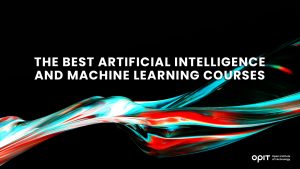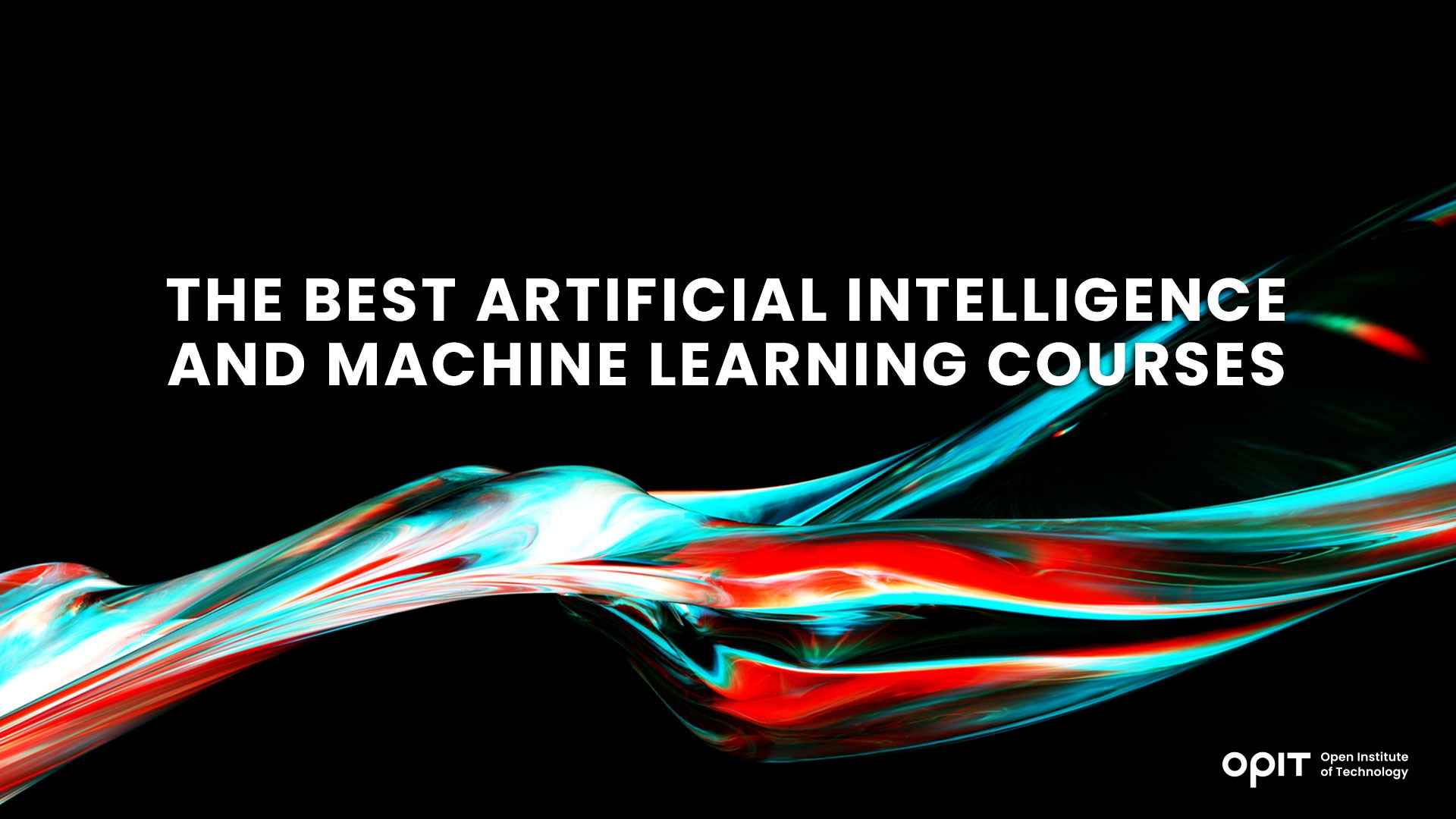

Every time you’ve chatted with a bot on a website, you’ve seen the basis of artificial intelligence (AI) and machine learning (ML) in action. Your experiences with augmented reality, any prompts you’ve ever delivered to ChatGPT, and a host of other technologies that businesses are already leveraging show us how crucial these two fields are, both today and in the future.
AI and ML are taking over the world. And with the right AI & ML courses, you put yourself in the ideal position to forge a career in an industry that’s set for a continuous annual growth rate of 36.2% between 2023 and 2030.
Factors to Consider When Choosing an AI and ML Course
AI ML courses come in all shapes and sizes, with some delivering the basics you need to build a foundation in the subjects and others moving on from those foundational concepts and into specializations. These five things are your biggest considerations when choosing a course.
1 – Course Content and Curriculum
What does the course teach? That’s not just an important question in terms of figuring out if the course helps you develop the skills you need, but it’s a crucial one for your future career prospects. The curriculum informs every step you take on your learning journey. If the content isn’t up to scratch (or takes you in a different direction than the one you intend to go in) it’s not the course for you.
2 – Course Duration and Flexibility
Combine work and family with your personal life and existing educational commitments and you have the recipe for a quagmire of time-consuming tasks that may not fit with a long-term course. The best AI and ML courses online offer flexibility, allowing you to fit your studies around other commitments and opening the door to self-paced learning.
3 – Your Instructors
Imagine you walk into a classroom and your instructor introduces themself. They tell you they have a couple of qualifications in the fields of AI and ML, but they haven’t worked in either industry and can’t expose you to professionals who have. Is that any use to you in your career? A good instructor combines technical expertise (which they’ll need a lot of) with industry experience they can draw on to lead you down the right career path.
4 – Course Reviews and Ratings
As any online marketer will tell you, user-generated content in the form of reviews, social media posts, and simple ratings tells you a ton about what a product delivers. That’s as true for AI and machine learning courses as it is for anything else. Check out what other people have to say about the course, paying special attention to former students and what’s happened to them in the wake of earning their certification.
5 – Pricing and Affordability
Money is always a challenge when it comes to education. Some universities charge tens of thousands of euros for their courses, which is fine if you can commit time and money to a full-time educational experience. It’s not so fine if you’re working on a budget. Your course’s cost plays a huge role in determining whether you take it. Just remember one thing – people tend to get what they pay for (for better or worse).
Top AI and ML Online Courses
Machine learning and artificial intelligence courses run the gamut from fast, industry-led courses designed to get you into a job to deeper degrees designed to equip you with everything you need to advance in your career. The following four are some of the best AI and ML courses online.
Course 1 – Master in Applied Data Science & AI (OPIT)
Designed for those at the postgraduate level, this Master’s degree requires you to have a background in computer science (or a relevant alternative). It’s a 100% online course that delivers an accredited degree under the European Qualification Framework (EQF), with the course also counting toward the college credits you may need to apply for future courses. Tutors are available for direct learning 24/7 and you learn via both recorded and live content delivered over the web.
Key Features and Benefits
- Offers tons of exposure to how machine learning and artificial intelligence apply in real-world scenarios
- You get a Master’s degree from a fully-accredited institution
- Favors progressive assessments over high-stress exams
- Control your own learning by arranging the course’s modules around your schedule
Enrollment Details
OPIT’s Master in Applied Data Science & AI comes in two flavors – the regular 18-month variety and a fast-tracked 12-month course. Enrollment is annual, with intake occurring every October, and the price varies depending on when you apply. Early birds get an extensive discount, paying €4,950 compared to the regular price of €6,500. You’ll need a relevant Bachelor’s degree in a subject like computer science to apply.
Course 2 – Machine Learning Introduction for Everyone (IBM via Coursera)
If OPIT’s Master’s degree is for people who are already halfway through the metaphorical marathon of machine learning and AI, IBM’s beginner’s course is for those at the starting line. It’s a seven-hour course that teaches the basics of AI and ML, in addition to helping you get to grips with the development cycle for a machine learning model. As a primer for the concepts, it’s one of the best AI ML online courses available.
Key Features and Benefits
- Provided by a Fortune 50 company that’s one of the leaders in the AI field
- Created by a Senior Data Scientist who currently works for IBM
- You receive a sharable certificate that looks great on your LinkedIn profile
- No completion of other AI machine learning courses is required to apply
Enrollment Details
“Free” is always a nice price tag to see on anything, and that’s what you get with this course, at least when trialing the course. Enrolment is semi-regular, with batches of students accepted every few months, and you get to reset deadlines based on when you can complete its modules. IBM says the course contains seven hours of content. Your experience may vary depending on how quickly (or otherwise) you adapt to the content.
Course 3 – Post Graduate Program in AI and Machine Learning (Purdue University)
Career Karma ranks this as one of the best AI ML courses online, and it’s hard to argue given that this is a near-year-long course offered with backing from industry professionals at IBM. It’s more bootcamp than formal course, though, so expect to be put through your paces with intensive hackathons and sprints that cover a huge number of AI tools. Combine that with real-world projects (using datasets from companies like Twitter and Uber) and you have a fast-paced and valuable course.
Key Features and Benefits
- Any extremely modern curriculum that takes in real-world examples from tech industry giants
- Backed by IBM to further the real-world experience delivered
- You receive a postgraduate certificate from an established university
- The online bootcamp experience is great for people who prefer fast-paced and intensive learning
Enrollment Details
Enrollment is set for May of each year, with the course lasting for 11 months thereafter. You’ll need to hit some criteria to apply. The course asks for a minimum of a Bachelor’s degree where you’ve obtained at least 50% on your modules, as well as a couple of years of work experience. That work experience requirement may be an issue for people who haven’t started their careers. Still, it’s a cost-effective program, with the course costing £2,990 (approx. €3,400).
Course 4 – Machine Learning Crash Course (Google AI)
If time is of the essence and you just want a crash course in what machine learning is and how it applies to your business, Google provides the answer with this option. At just 15 hours, it’s a course you can complete over an intensive weekend of study. It’ll introduce you to some real-world case studies, with lectures coming directly from industry heads at Google.
Key Features and Benefits
- Contains 25 lessons (with 30 exercises) to expand and test your knowledge
- Get industry insight from Google experts who work in the AI and ML fields
- You don’t have to pay a euro to take part in this course
- Includes interactive visualizations of real-world models that are great for tinkerers
Enrollment Details
Google presumes no prior knowledge of machine learning in this course, though it recommends that you’re comfortable with programming in Python and understand complex statistical concepts. Knowledge of the NumPy library is especially helpful. Assuming you build up a knowledge base (Google offers other courses to cover these foundations), you can enroll at any time and get a free course that you can fit around your schedule.
Additional Resources for AI and ML Learning
Great AI ML courses can teach you the fundamentals and offer direct experience, ideally coming from professionals in the industry. But it’s what you do outside of your formal and certified studies that can make the biggest difference to your career prospects. These additional resources both supplement what you learn from the above courses and allow you to continue developing your skills once you have your shiny new certificate:
- Online forums and communities
- Podcasts and YouTube channels dedicated to machine learning and AI
- Books and eBooks
- Conferences, workshops, and career-centric bootcamps
Use AI & ML Courses Today to Benefit Tomorrow
Consider these facts if you need any more convincing that AI and machine learning courses are right for you. The average machine learning engineer earns between €66,585 and €118,169 per year, with jobs in AI easily climbing into the six-figure range as well. Your career prospects get a boost when you study AI and ML. But remember – a certification alone is not enough.
These are fast-evolving fields, and only those who dedicate themselves to continued learning (and the adaptation that comes with market changes) excel. Start your journey with one of the four courses in this article and then continue down the educational path.
Related posts

Source:
- The Yuan, Published on October 25th, 2024.
By Zorina Alliata
Artificial intelligence is a classic example of a mismatch between perceptions and reality, as people tend to overlook its positive aspects and fear it far more than what is warranted by its actual capabilities, argues AI strategist and professor Zorina Alliata.
ALEXANDRIA, VIRGINIA – In recent years, artificial intelligence (AI) has grown and developed into something much bigger than most people could have ever expected. Jokes about robots living among humans no longer seem so harmless, and the average person began to develop a new awareness of AI and all its uses. Unfortunately, however – as is often a human tendency – people became hyper-fixated on the negative aspects of AI, often forgetting about all the good it can do. One should therefore take a step back and remember that humanity is still only in the very early stages of developing real intelligence outside of the human brain, and so at this point AI is almost like a small child that humans are raising.
AI is still developing, growing, and adapting, and like any new tech it has its drawbacks. At one point, people had fears and doubts about electricity, calculators, and mobile phones – but now these have become ubiquitous aspects of everyday life, and it is not difficult to imagine a future in which this is the case for AI as well.
The development of AI certainly comes with relevant and real concerns that must be addressed – such as its controversial role in education, the potential job losses it might lead to, and its bias and inaccuracies. For every fear, however, there is also a ray of hope, and that is largely thanks to people and their ingenuity.
Looking at education, many educators around the world are worried about recent developments in AI. The frequently discussed ChatGPT – which is now on its fourth version – is a major red flag for many, causing concerns around plagiarism and creating fears that it will lead to the end of writing as people know it. This is one of the main factors that has increased the pessimistic reporting about AI that one so often sees in the media.
However, when one actually considers ChatGPT in its current state, it is safe to say that these fears are probably overblown. Can ChatGPT really replace the human mind, which is capable of so much that AI cannot replicate? As for educators, instead of assuming that all their students will want to cheat, they should instead consider the options for taking advantage of new tech to enhance the learning experience. Most people now know the tell-tale signs for identifying something that ChatGPT has written. Excessive use of numbered lists, repetitive language and poor comparison skills are just three ways to tell if a piece of writing is legitimate or if a bot is behind it. This author personally encourages the use of AI in the classes I teach. This is because it is better for students to understand what AI can do and how to use it as a tool in their learning instead of avoiding and fearing it, or being discouraged from using it no matter the circumstances.
Educators should therefore reframe the idea of ChatGPT in their minds, have open discussions with students about its uses, and help them understand that it is actually just another tool to help them learn more efficiently – and not a replacement for their own thoughts and words. Such frank discussions help students develop their critical thinking skills and start understanding their own influence on ChatGPT and other AI-powered tools.
By developing one’s understanding of AI’s actual capabilities, one can begin to understand its uses in everyday life. Some would have people believe that this means countless jobs will inevitably become obsolete, but that is not entirely true. Even if AI does replace some jobs, it will still need industry experts to guide it, meaning that entirely new jobs are being created at the same time as some older jobs are disappearing.
Adapting to AI is a new challenge for most industries, and it is certainly daunting at times. The reality, however, is that AI is not here to steal people’s jobs. If anything, it will change the nature of some jobs and may even improve them by making human workers more efficient and productive. If AI is to be a truly useful tool, it will still need humans. One should remember that humans working alongside AI and using it as a tool is key, because in most cases AI cannot do the job of a person by itself.
Is AI biased?
Why should one view AI as a tool and not a replacement? The main reason is because AI itself is still learning, and AI-powered tools such as ChatGPT do not understand bias. As a result, whenever ChatGPT is asked a question it will pull information from anywhere, and so it can easily repeat old biases. AI is learning from previous data, much of which is biased or out of date. Data about home ownership and mortgages, e.g., are often biased because non-white people in the United States could not get a mortgage until after the 1960s. The effect on data due to this lending discrimination is only now being fully understood.
AI is certainly biased at times, but that stems from human bias. Again, this just reinforces the need for humans to be in control of AI. AI is like a young child in that it is still absorbing what is happening around it. People must therefore not fear it, but instead guide it in the right direction.
For AI to be used as a tool, it must be treated as such. If one wanted to build a house, one would not expect one’s tools to be able to do the job alone – and AI must be viewed through a similar lens. By acknowledging this aspect of AI and taking control of humans’ role in its development, the world would be better placed to reap the benefits and quash the fears associated with AI. One should therefore not assume that all the doom and gloom one reads about AI is exactly as it seems. Instead, people should try experimenting with it and learning from it, and maybe soon they will realize that it was the best thing that could have happened to humanity.
Read the full article below:

Source:
- The European Business Review, Published on October 27th, 2024.
By Lokesh Vij
Lokesh Vij is a Professor of BSc in Modern Computer Science & MSc in Applied Data Science & AI at Open Institute of Technology. With over 20 years of experience in cloud computing infrastructure, cybersecurity and cloud development, Professor Vij is an expert in all things related to data and modern computer science.
In today’s rapidly evolving technological landscape, the fields of blockchain and cloud computing are transforming industries, from finance to healthcare, and creating new opportunities for innovation. Integrating these technologies into education is not merely a trend but a necessity to equip students with the skills they need to thrive in the future workforce. Though both technologies are independently powerful, their potential for innovation and disruption is amplified when combined. This article explores the pressing questions surrounding the inclusion of blockchain and cloud computing in education, providing a comprehensive overview of their significance, benefits, and challenges.
The Technological Edge and Future Outlook
Cloud computing has revolutionized how businesses and individuals’ access and manage data and applications. Benefits like scalability, cost efficiency (including eliminating capital expenditure – CapEx), rapid innovation, and experimentation enable businesses to develop and deploy new applications and services quickly without the constraints of traditional on-premises infrastructure – thanks to managed services where cloud providers manage the operating system, runtime, and middleware, allowing businesses to focus on development and innovation. According to Statista, the cloud computing market is projected to reach a significant size of Euro 250 billion or even higher by 2028 (from Euro 110 billion in 2024), with a substantial Compound Annual Growth Rate (CAGR) of 22.78%. The widespread adoption of cloud computing by businesses of all sizes, coupled with the increasing demand for cloud-based services and applications, fuels the need for cloud computing professionals.
Blockchain, a distributed ledger technology, has paved the way by providing a secure, transparent, and tamper-proof way to record transactions (highly resistant to hacking and fraud). In 2021, European blockchain startups raised $1.5 billion in funding, indicating strong interest and growth potential. Reports suggest the European blockchain market could reach $39 billion by 2026, with a significant CAGR of over 47%. This growth is fueled by increasing adoption in sectors like finance, supply chain, and healthcare.
Addressing the Skills Gap
Reports from the World Economic Forum indicate that 85 million jobs may be displaced by a shift in the division of labor between humans and machines by 2025. However, 97 million new roles may emerge that are more adapted to the new division of labor between humans, machines, and algorithms, many of which will require proficiency in cloud computing and blockchain.
Furthermore, the World Economic Forum predicts that by 2027, 10% of the global GDP will be tokenized and stored on the blockchain. This massive shift means a surge in demand for blockchain professionals across various industries. Consider the implications of 10% of the global GDP being on the blockchain: it translates to a massive need for people who can build, secure, and manage these systems. We’re talking about potentially millions of jobs worldwide.
The European Blockchain Services Infrastructure (EBSI), an EU initiative, aims to deploy cross-border blockchain services across Europe, focusing on areas like digital identity, trusted data sharing, and diploma management. The EU’s MiCA (Crypto-Asset Regulation) regulation, expected to be fully implemented by 2025, will provide a clear legal framework for crypto-assets, fostering innovation and investment in the blockchain space. The projected growth and supportive regulatory environment point to a rising demand for blockchain professionals in Europe. Developing skills related to EBSI and its applications could be highly advantageous, given its potential impact on public sector blockchain adoption. Understanding the MiCA regulation will be crucial for blockchain roles related to crypto-assets and decentralized finance (DeFi).
Furthermore, European businesses are rapidly adopting digital technologies, with cloud computing as a core component of this transformation. GDPR (Data Protection Regulations) and other data protection laws push businesses to adopt secure and compliant cloud solutions. Many European countries invest heavily in cloud infrastructure and promote cloud adoption across various sectors. Artificial intelligence and machine learning will be deeply integrated into cloud platforms, enabling smarter automation, advanced analytics, and more efficient operations. This allows developers to focus on building applications without managing servers, leading to faster development cycles and increased scalability. Processing data closer to the source (like on devices or local servers) will become crucial for applications requiring real-time responses, such as IoT and autonomous vehicles.
The projected growth indicates a strong and continuous demand for blockchain and cloud professionals in Europe and worldwide. As we stand at the “crossroads of infinity,” there is a significant skill shortage, which will likely increase with the rapid adoption of these technologies. A 2023 study by SoftwareOne found that 95% of businesses globally face a cloud skills gap. Specific skills in high demand include cloud security, cloud-native development, and expertise in leading cloud platforms like AWS, Azure, and Google Cloud. The European Commission’s Digital Economy and Society Index (DESI) highlights a need for improved digital skills in areas like blockchain to support the EU’s digital transformation goals. A 2023 report by CasperLabs found that 90% of businesses in the US, UK, and China adopt blockchain, but knowledge gaps and interoperability challenges persist.
The Role of Educational Institutions
This surge in demand necessitates a corresponding increase in qualified individuals who can design, implement, and manage cloud-based and blockchain solutions. Educational institutions have a critical role to play in bridging this widening skills gap and ensuring a pipeline of talent ready to meet the demands of this burgeoning industry.
To effectively prepare the next generation of cloud computing and blockchain experts, educational institutions need to adopt a multi-pronged approach. This includes enhancing curricula with specialized programs, integrating cloud and blockchain concepts into existing courses, and providing hands-on experience with leading technology platforms.
Furthermore, investing in faculty development to ensure they possess up-to-date knowledge and expertise is crucial. Collaboration with industry partners through internships, co-teach programs, joint research projects, and mentorship programs can provide students with invaluable real-world experience and insights.
Beyond formal education, fostering a culture of lifelong learning is essential. Offering continuing education courses, boot camps, and online resources enables professionals to upskill or reskill and stay abreast of the latest advancements in cloud computing. Actively promoting awareness of career paths and opportunities in this field and facilitating connections with potential employers can empower students to thrive in the dynamic and evolving landscape of cloud computing and blockchain technologies.
By taking these steps, educational institutions can effectively prepare the young generation to fill the skills gap and thrive in the rapidly evolving world of cloud computing and blockchain.
Read the full article below:
Have questions?
Visit our FAQ page or get in touch with us!
Write us at +39 335 576 0263
Get in touch at hello@opit.com
Talk to one of our Study Advisors
We are international
We can speak in:


